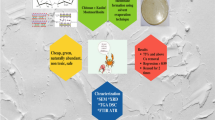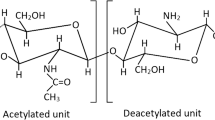Abstract
Purpose
Chitosan with nylon 6 membranes was evaluated as adsorbents to remove copper and cadmium ions from synthetic industrial wastewater.
Methods
Chitosan and nylon 6 with glutaraldehyde blend ratio with (1:1+Glu, 1:2+Glu, and 2:1+Glu) have been prepared and these were used as membranes to remove copper and cadmium ions from synthetic industrial wastewater. Characterization of the synthesized membrane has been done with FTIR, XRD, TGA/DTA, DSC, and SEM. Chemical parameters for quantities of adsorption of heavy metal contamination have been done and the kinetics of adsorption has also been carried out.
Results
The optimal pH for the removal of Cd(II) and Cu(II) using chitosan with nylon 6. Maximum removal of the metals was observed at pH 5 for both the metals. The effect of adsorbent dose also has a pronounced effect on the percentage of removal of the metals. Maximum removal of both the metals was observed at 5 g/100 ml of the adsorbent.
Conclusion
Copper and cadmium recovery is parallel at all time. The percentage of removal of copper increased with increase in the pH from 3 to 5. In the case of cadmium containing wastewater, the maximum removal of metal occurred at pH 5. The uptake amount of Cu2+ ions on chitosan increased rapidly with increasing contact time from 0 to 360 min and then reaches equilibrium after 360 min; the equilibrium constant for copper and cadmium ions is more or less the same for the adsorption reaction.
















Similar content being viewed by others
References
Ali I, Gupta VK (2006) Advances in water treatment by Adsorption Technology. Nat Protoc 1(6):2661–2667
Elisaveta K, Mladenova I, Grigorova D, Irina KB (2011) Chitosan membrances as sorbents for trace elements determination in surface waters. Environ Sci Pollut Res 18:1633–1643
Finqueneised G, Zimmy T, Vogt D, Weber JW (1998) Feasibility of the preparation of effective cheap adsorbents from lignites in rotary kiln. Fuel Process Technol 57:196
Gang S, Weixing S (1998) Sunflower stalk as adsorbents for the removal of metal ions from waste water. Ind Eng Chem Res 37(4):1324–1328
Gupta VK, Ali I (2004) Removal of lead and chromium from wastewater using bagasse fly ash—a sugar industry waste. J Colloid Interface Sci 271:321–328
Gupta VK, Rastogi A (2008a) Equilibrium and kinetic modelling of cadmium (II) biosorption by non-living algal biomass Oedogonium Sp from aueeous phase. J Hazard Mater 153:759–766
Gupta VK, Rastogi A (2008b) Biosorption of Lead (II) from aqueous solutions by non-living algal biomass Oedogonium sp and Nostoc sp—a comparative study. Colloids and Surface B: Biointerfaces 64:170–178
Gupta VK, Rastogi A (2008c) Sorption and desorption studies of chromium (VI) from non viable Cyanobacterium Nostoc Museorum biomass. J Hazard Mater 154:347–354
Gupta VK, Rastogi A (2009) Biosorption of hexavalent chromium by raw and acid-treated green alga Oedogoniumhatei from aqueous solutions. J Hazard Mater 163:396–402
Gupta VK, Sharma S (2003) Removal of zinc from aqueous solutions using Bagasse Fly Ash a low cost adsorbent. Ind Eng Res 42:6619–6624
Gupta VK, Rastogi A, Dwivedi MK, Mohan D (1997) Process development for the removal of zinc and cadmium from wastewater using slag—a blast furnace waste material. Separa Sci Technol 32(17):2883–2912
Gupta VK, Mohan D, Sharma S (1998) Removal of lead from wastewater using bagasse fly ash—a sugar industry waste material. Separa Sci Technol 33(9):1331–1343
Gupta VK, Mohan D, Sharma S, Park KT (1999) Removal of chromium (VI) from electroplating industry wastewater using bagasse fly ash—a sugar industry waste material. Environmentalist 19:129–139
Gupta VK, Srivastava SK, Tyagi R (2000) Design parameters for the treatment of phenolic wastes by carbon columns (obtained from fertilizer waste material). Water Res 34(5):1543–1550
Gupta VK, Gupta M, Sharma S (2001) Process development for the removal of lead and chromium from aqueous solutions using red mud—an aluminium industry waste. Water Res 35(5):1125–1134
Gupta VK, Mangla R, Agarwal S (2002) Pb (II) selective potentiometric sensor based on 4-tert-lcalix[4]arene in PVC matrix. Electroanalysis 14(15–16):1127–1132
Gupta VK, Singh P, Rahman N (2004) Adsorption behavior of Hg(II), Pb(II) and Xd(II) from aqueous solution on Duolite C-433: a synthetic resin. J Colloid Interface Sci 275:398–402
Gupta VK, Mittal A, Gajbe V, Mittal J (2006) Removal and recovery of the hazardous azo dye acid orange 7 through adsorption over waste material: bottom ash and de-oiled soya. Ind Eng Chem Res 45:1446–1453
Gupta VK, Ali I, Vipin KS (2007a) Adsorption studies on the removal of Vertigo Blue 49 and Orange DNA 13 from aqueous solutions using carbon slurry developed from a waste material. J Colloid Interface Sci 315:87–93
Gupta VK, Jain R, Varshney S (2007b) Removal of reactorfix golden yellow 3 RFN from aqueous using wheat husk—an agricultural waste. J Hazard Mater 142:448–448
Gupta VK, Jain R, Mittal A, Mathur M, Sivkarwar S (2007c) Photochemical degradation of the hazardous dye safranin-T using TiO2 catalyst. J Colloid Interface Sci 309:464–469
Gupta VK, Singh AK, Gupta B (2007d) Schiff bases as cadmium (II) selective ionophores in polymericmembrane electrodes. Anal Chim Acta 583(2–5):340–348
Gupta VK, Carrott PJM, Ribeiro Carrott MML, Suhas (2009a) Low cost adsorbents: growing approach to wastewater treatment. A review. Critical Reviews in Environ Sci Technol 39:783–842
Gupta VK, Al Khayat M, Singh AK, Pal MK (2009b) Nano level detection of Cd (II) using poly (vinyl chloride) based membranes of Schiff bases. Analytica Chimica Act 634(1–16):36–43
Gupta VK, Goyal RN, Sharma RA (2009c) Novel alizarin sensor for determination of Vanadium, Zirconium and Molybdenum. Int J Electrochem Sci 4:156–172
Gupta VK, Rastogi A, Nayak A (2010) Adsorption studies on the removal of hexavalent chromium from aqueous solution using a low cost fertilizer industry waste material. J Colloid Interface Sci 342:135–141
Hasan S, Krishnaiah A, Ghosh TK, Viswanath DS, Boddu VM, Smith ED (2006) Adsorption of divalent cadmium (II) from aqueous solutions onto chitosan coated perlite beads. Ind Eng Chem Res 45:5066–5077
Ho YS (2003) Removal of copper ions from aqueous solution by tree fern. Water Res 37:2323–2330
Ho YS, McKay G (1998) Kinetic studies of dye sorption by biosorbent waste product pith. Resour Conserv Recycl 25(3–4):171–193
Hodi M, Polyak K, Htavay J (1995) Removal of pollutants from drinking water by combined ion exchange and adsorption methods. Environ Int 21:325–328
Igwe JC, Abia AA (2003) Maize cob and husk as adsorbents for removal of Cd, Pb and Zn ions from wastewater. The Physical Sci 2:83–94
Jain AK, Gupta VK, Sahoo BB, Singh LP (1995a) Copper (II)-selective electrodes based on macrocyclic compounds. Anal Proc Incl Anal Commun 32:99–101
Jain AK, Gupta VK, Singh LP (1995b) Neutral carrier and organic resin based membranes as sensors for uranyl ions. Anal Proc Incl Anal Commun 32:263–265
Jain AK, Gupta VK, Singh LP, Khurana U (1997a) A new cerium (IV) vanadate-based solid membrane electrode for bismuth (III). Electroanalysis 9:360–1364
Jain AK, Gupta VK, Khurana U, Singh LP (1997b) A new membrane sensor for UO2+2 ions based on 2-hydroxyacetophenoneoxime-thiourea-trioxane resin. Electroanalysis 9(11):857–860
Khutoryanskiy VV, Cascone MG, Lazzeri L, Nurkeeva ZS, Mun GA, Mangazbaeva R (2003) Phase behavior of methylcellulose–poly (acrylic acid) blends and preparation of related hydrophilic films. Polym Int 52:62–67
Kim CH, Oda T, Itoh M, Jiang D, Artinger KB, Chandrasekharappa SC, Driever W, Chitnis AB (2000) Repressor activity of headless/Tcf3 is essential for vertebrate head formation. Nature 407(6806):913–916
Li N, Bai R (2005) A novel amine-shielded surface cross-linking of chitosan hydrogel beads for enhanced metal adsorption performance. Ind Eng Chem Res 44:6692–6700
Liang CY, Marchessault RH (1959) Infrared spectra of crystalline polysaccharides. I. Hydrogen bonds in native celluloses. J Polym Sci 37:385–395
Liu J, Zhang X-H, Tran H, Wang D-Q, Zhu Y-N (2011) Heavy metal contamination and risk assessment in water, paddy soil and rice around electroplating plant. Environ Sci Pollut Res 18:1623–1632
Llorens J, Pujola M, Sabate J (2004) Separation of cadmium from aqueous streams by polymer enhanced ultrafiltration: a two-phase model for complexation binding. J Membr Sci 239:173–181
Mucha M, Pawlak A (2005) Thermal analysis of chitosan and its blends. Thermo Chimica Acta 427:69–76
Namasivayam C, Senthilkumar S (1998) Removal of Arsenic (V) from aqueous solution using industrial solid waste: adsorption rates and equilibrium studies. Ind Eng Chem Res 37:4816–4822
Navarro R, Guzman J, Saucedo I, Revilla J, Guibal E (2003) Recovery of metal ions by chitosan: sorption mechanisms and influence of metal speciation. Macromol Biosci 3:552–561
Nelson A, Cosgrove T (2004) Langmuir 20:2298–2304
Nomanbhay SM, Palanisamy K (2005) Removal of heavy metal from industrial wastewater using chitosan coated oil palm shell charcoal. Electronic J Biotechnol 8:43–53
Okieimen FE, Maya AO, Oriakhi CO (1988) Sorption of cadmium, lead and zinc ions on sulphur containing chemically modified cellulosic materials. Int J Environ Anal Chem 32:23–27
Ritthidej GC, Phaechamud T, Koizumi T (2002) Moist heat treatment on physicochemical change of chitosan salt films. Int J Pharma 232:11–22
Sadiq M, Zaida TH, Mian AA (1983) Water Air Soil Pollut 20:369–374
Schmuhl R, Krieg HM, Keizer K (2001) Adsorption of Cu (II) and Cr (VI) ions by chitosan: kinetics and equilibrium studies. Water SA 27:1–7
Sivaraj R, Namasivayam C, Kadirvelu K (2001) Orange peel as an adsorbent in the removal of acid violet 17 (acid dye) from aqueous solution. Waste Manag 21:105–110
Srivastava SK, Gupta VK, Dwivedi MK, Jain S (1995a) Cesium PVC-Crown (dibenzo-24-crown-8) based membrane sensor. Anal Proc Incl Anal Commun 32:21–23
Srivastava SK, Gupta VK, Jain S (1995b) Determination of lead using poly (vinyl chloride) based crown ether membrane. Analyst 120:495–498
Srivastava SK, Gupta VK, Jain S (1996a) PVC-based 2, 2, 2-Cryptand sensors for zinc ions. Anal Chem 68:1272–1275
Srivastava SK, Gupta VK, Jain S (1996b) A PVC-based benzo-15-crown-5 membrane sensor for cadmium. Electroanalysis 8:938–940
Srivastava SK, Gupta VK, Mohan D (1997) Removal of lead and chromium by activated slag—a blast-furnace waste. J Environ Engin 123(5):461–468
Sun Q, Yang L (2003) The adsorption of basic dyes from aqueous solutions on modified peat–resin particle. Water Res 37:1535–1544
Xu J, McCarthy SP, Gross RA (1996) Chitosan film acetylation and effect on bio-degradability. Macromolecules 29:3436–3440
Zouboulis AI, Matis KA, Stalidis GA (1992) Flotation methods andtechniques in wastewater. In: Mavros P, Matis KA (Eds) Innovations in flotation technology. Kluwer Academic Dordrecht: NL, pp 96–104
Author information
Authors and Affiliations
Corresponding author
Additional information
Responsible editor: Vinod Kumar Gupta
Rights and permissions
About this article
Cite this article
Prakash, N., Sudha, P.N. & Renganathan, N.G. Copper and cadmium removal from synthetic industrial wastewater using chitosan and nylon 6. Environ Sci Pollut Res 19, 2930–2941 (2012). https://doi.org/10.1007/s11356-012-0801-8
Received:
Accepted:
Published:
Issue Date:
DOI: https://doi.org/10.1007/s11356-012-0801-8




